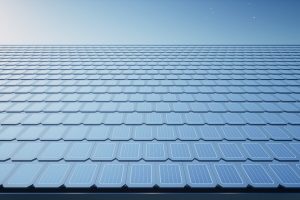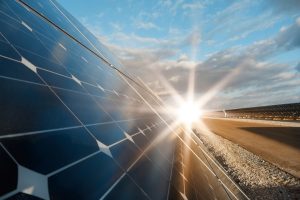
Investing in commercial solar not only fulfills sustainability objectives but also enhances the financial health of your business. With various incentives and financing options available, transitioning to solar energy can be both an economically sound and environmentally friendly decision.
Below we’ll discuss why businesses should invest in commercial solar energy and the typical return on investment (ROI) timeline.
The key benefits of commercial solar include:
- Sustainability: Contributing to environmental goals while enhancing corporate responsibility.
- Financial Advantages: Significant savings on electricity costs, leading to improved profit margins.
- Quick Return on Investment: Many businesses experience a relatively fast payback period, making solar a practical choice.
Understanding these aspects empowers businesses to make informed choices about their energy and financial planning.
Understanding Commercial Solar Systems
Commercial solar systems consist of several components that work together to harness solar energy and convert it into usable electricity. The primary elements include:
- Solar Panels: These are the heart of the system, capturing sunlight and transforming it into electricity through photovoltaic cells.
- Inverters: Inverters convert the direct current (DC) produced by solar panels into alternating current (AC), which is the form of electricity used by most businesses.
- Monitoring Systems: These allow you to track the performance and efficiency of your solar system, ensuring optimal energy production.
When considering commercial solar panels, it’s essential to understand the different types available:
- Monocrystalline Panels: Known for their high efficiency (17-20%), these panels are made from single crystal structures and perform well in limited space.
- Polycrystalline Panels: Slightly less efficient (15-17%), these are made from multiple crystal structures and are often more affordable.
- Thin-Film Panels: With an efficiency range of 6-15%, they are lightweight and flexible but require more space for installation.
- PERC Panels: These advanced panels can achieve efficiencies up to 25%, making them a top choice for commercial applications where maximizing output is crucial.
Installation Costs and Financial Benefits
Understanding installation costs for commercial solar is crucial for businesses considering this investment. Typical costs can vary widely based on several factors, including:
- System Size: Larger installations often benefit from economies of scale.
- Panel Type: Different efficiencies and technologies (e.g., monocrystalline vs. thin-film) influence cost.
- Labor: Installation complexity and location affect labor costs significantly.
- Permitting and Incentives: Local regulations and available incentives can impact upfront expenses.
Investing in commercial solar offers significant financial benefits, primarily through two key metrics: ROI (Return on Investment) and IRR (Internal Rate of Return).
- ROI measures the total profitability of the investment over time. For example, a $100k investment yielding $150k savings over five years results in a 150% ROI.
- IRR evaluates the expected annual return, factoring in future energy savings. Solar installations often demonstrate impressive IRR rates above 32%.
Calculating ROI and Payback Period for Solar Installations
Calculating the ROI for solar installations involves several key steps:
- Estimating Installation Costs: This includes all expenses related to acquiring and installing the solar system. Consider factors such as equipment, labor, permits, and any additional infrastructure or upgrades needed.
- Forecasting Energy Production/Savings: Analyze historical electricity usage data to project future energy needs. Utilize solar production calculators or software tools to estimate the amount of energy your system will generate based on its size, panel efficiency, and local sunlight exposure.
Understanding the payback period is crucial in financial planning for businesses. It represents the time required for savings from reduced energy bills to equal the initial investment. A shorter payback period indicates a quicker recovery of costs and enhances investment attractiveness.
Key insights include:
- Short payback periods (typically 5-10 years) are common in commercial solar investments.
- Businesses can anticipate substantial long-term savings, further enhancing their return on investment.
Strategies to Maximize Your Solar Investment
Maximizing your ROI in solar projects requires strategic planning and execution. Consider the following approaches:
1. System Design Optimization
Enhance energy output by focusing on sun exposure. Conduct a site analysis to identify optimal locations for panel placement.
Choose high-efficiency panels. For example, PERC panels, with efficiencies reaching up to 25%, can generate more electricity in limited space compared to traditional options.
2. Exploring Financing Options
Evaluate various financing methods such as loans, which often offer attractive interest rates.
Consider Power Purchase Agreements (PPAs), allowing you to finance solar systems with little to no upfront costs while purchasing the generated electricity at a fixed rate.
Take advantage of available tax credits. The federal investment tax credit provides a significant reduction in installation costs, making solar investments more financially viable.
Implementing these strategies can significantly improve your financial outcomes from solar investments, allowing for quicker payback periods and higher net savings over time.
Overcoming Challenges in Commercial Solar Installation
Commercial solar installation presents several challenges that businesses must navigate:
1. High Upfront Costs
The initial financial investment can deter many businesses from pursuing solar energy. Utilizing financing options such as Power Purchase Agreements (PPAs) or solar loans can alleviate this burden, allowing companies to pay for their systems over time.
2. Space Limitations
Not all commercial buildings have sufficient rooftop space for solar panels. Flexible panel options such as solar carports or vertical installations can optimize available areas, ensuring efficient use of space.
3. Dependency on Location and Sunlight
Geographic factors impact energy production. Businesses in less sunny regions may benefit from advancements in technology, including tracking systems that adjust panel angles to maximize sunlight exposure.
Addressing these challenges requires careful planning and consideration of innovative solutions that enhance the feasibility and effectiveness of commercial solar installations.
The Long-Term Impact of Commercial Solar on Businesses
Investing in commercial solar systems offers significant long-term benefits that extend beyond immediate financial savings. Key advantages include:
- Increased Property Value: Properties with solar installations often command higher market prices. Studies indicate that homes with solar can sell for 4.1% more than those without, a trend applicable to commercial properties as well.
- Energy Independence: Generating your own electricity reduces reliance on external energy sources, shielding your business from fluctuating energy prices. This stability can enhance overall operational efficiency.
- Sustainability Branding: Companies embracing renewable energy solutions project a positive image, appealing to environmentally conscious consumers and stakeholders.
These factors contribute to a solid case for why businesses should get commercial solar installations. With the typical ROI timeline favoring early investment, the long-term impact solidifies both economic and ethical advantages for forward-thinking enterprises.
Don’t Wait to Join Other Austin Businesses! Get Your Free Solar Quote
Embracing commercial solar investment offers numerous benefits:
- Economic savings: Slash your electricity bills and enhance your bottom line.
- Environmental impact: Contribute to sustainability and reduce your carbon footprint.
- Increased property value: Boost your asset’s worth with renewable energy enhancements.
Take action now. Many businesses in Austin are already experiencing these advantages. Request your free solar quote today and explore why businesses should get commercial solar and its typical ROI timeline.
Frequently Asked Questions About Commercial Solar
What are the primary benefits of investing in commercial solar for businesses?
Investing in commercial solar contributes to sustainability and offers significant financial advantages. Businesses can reduce their energy costs, increase property value, and gain energy independence, all while supporting renewable energy initiatives.
What types of commercial solar panels are available?
There are several types of commercial solar panels including monocrystalline, polycrystalline, thin-film, and PERC panels. Each type has its own characteristics regarding efficiency, cost, and installation suitability.
How do installation costs for commercial solar systems vary?
Installation costs for commercial solar systems can vary based on factors such as system size, panel type, installation complexity, and location. Understanding these factors is crucial for accurate budgeting.
What is the difference between ROI and IRR in commercial solar investments?
ROI (Return on Investment) measures the profitability of an investment relative to its cost, while IRR (Internal Rate of Return) represents the expected annualized return over the life of the investment. Both metrics help businesses evaluate the financial viability of solar projects.
What strategies can businesses employ to maximize their solar investment?
Businesses can enhance ROI by optimizing system design for maximum sun exposure and panel efficiency. Exploring financing options such as loans, Power Purchase Agreements (PPAs), and tax credits can further improve financial outcomes.
How does investing in commercial solar impact a business’s property value?
Investing in commercial solar can lead to an increase in property value due to lower operating costs and enhanced appeal as a sustainable business. It positions the business as environmentally responsible, which can attract more customers.
from: https://mydividedsky.com/why-businesses-should-get-commercial-solar-and-its-typical-roi-timeline/


No comments:
Post a Comment